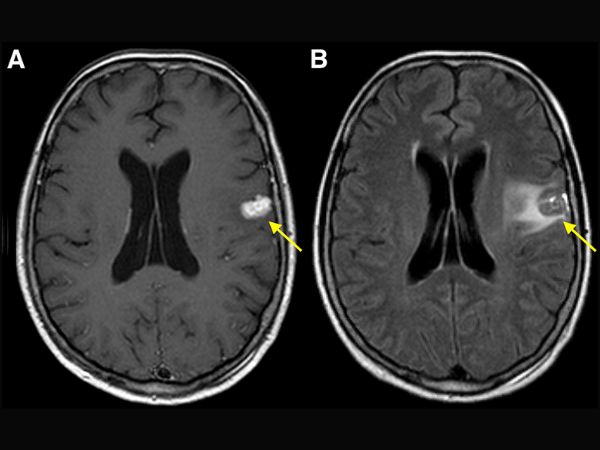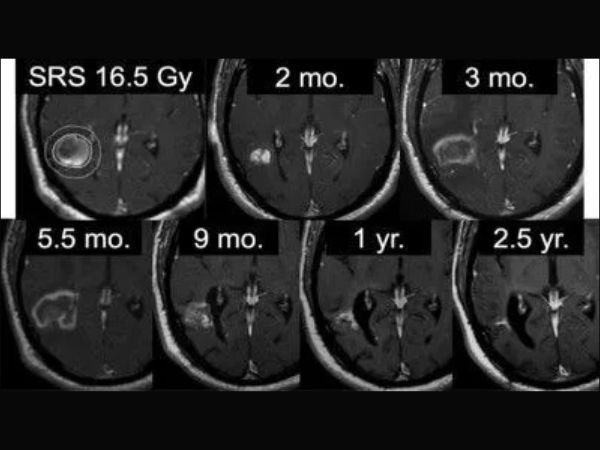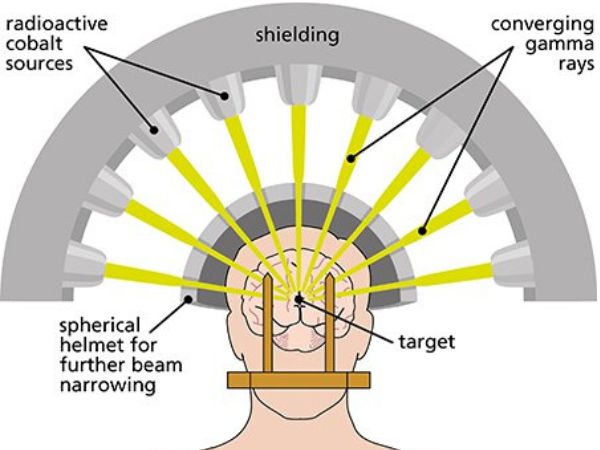Topics
Table of Contents
Treatment for a variety of brain illnesses, including vascular malformations, brain tumours, and functional problems like trigeminal neuralgia, has been transformed by Gamma Knife Radiosurgery (GKRS). GKRS, which is well-known for its accuracy and non-invasiveness, targets and eliminates abnormal tissue while protecting nearby healthy brain structures with concentrated radiation beams.

It does, however, include some risk, just like any medical operation. Understanding the potential Adverse Radiation Effects (AREs) after treatment is one of the most crucial factors for both patients and clinicians.
The definition, causes, symptoms, diagnosis, treatment, and ways to reduce AREs are all covered in this article.
Adverse Radiation Effects (AREs): What Are They?
Unwanted changes in brain tissue brought on by the high-dose, concentrated radiation used in Gamma Knife Radiosurgery are known as Adverse Radiation Effects (AREs). Even though GKRS reduces exposure to nearby tissues, radiation harm might cause short-term or long-term negative effects in certain people.
From minor swelling and temporary neurological symptoms to more severe side effects like radionecrosis (radiation-induced tissue death), these consequences can vary widely.
Adverse Radiation Effect Types

Acute Impacts (Days to Weeks)
- Rare with Gamma Knife
- May consist of localised swelling, headache, or nausea.
- Caused by transient swelling or inflammation at the treatment location
- Subacute Side Effects: 1–6 Months Following Therapy
Common
- Incorporate fatigue, slight cognitive impairments, or localised brain swelling.
- Typically reversible and conservatively handled
- Late Effects: Six Months to Years Following Therapy
May consist of:
- Dead brain tissue brought on by radiation damage is known as radiation necrosis.
- Swelling: a buildup of fluid that results in symptoms and pressure
- Calcification or cyst development in the treated area
- Memory issues, seizures, or delayed neurological deficiencies
What Leads to AREs?
The probability of getting AREs is affected by multiple factors, including:
- Radiation Dose: Risk is increased by higher dosages or greater treatment volumes.
- Lesion location: Eloquent brain regions, optic pathways, and the brainstem are particularly sensitive.
- Lesion Size: Greater treatment volumes are needed for larger lesions.
- Tissue sensitivity is increased by prior radiation exposure.
- Patient-specific factors include genetic vulnerability, age, and medical comorbidities.
Adverse Radiation Effect Symptoms

Depending on the part of the brain that is impacted, symptoms can include:
- A headache
- Vomiting or feeling queasy
- Limb weakness or numbness
- Seizures
- Having trouble understanding or speaking the language
- Changes in vision
- Cognitive decline or memory loss
Recognising Adverse Effects of Radiation
To distinguish AREs from tumour recurrence or disease progression, a prompt and precise diagnosis is crucial. Among the tools utilised are:
- MRI with contrast: Displays changes and swelling in the treated area
- MR Spectroscopy or Perfusion Imaging: Assists in distinguishing between tumour recurrence and radiation necrosis
- PET scans are occasionally used to evaluate brain metabolism.
- Clinical Evaluation: History of symptoms and neurological examination
Control and Handling of AREs
The intensity of the symptoms determines the course of treatment:
- Observation
- Numerous AREs self-limit and are tracked by routine MRIs.
- Drugs
- Steroids help lessen brain oedema and inflammation, such as dexamethasone
- If seizures happen, anti-seizure drugs
- Supportive care and pain management
- Bevacizumab
- A targeted treatment that inhibits VEGF, a protein that causes new blood vessel growth and edema, decreases swelling and improves radiation necrosis symptoms
- Surgery
- Although rarely required, it could be carried out in cases of severe necrosis, cyst formation, or unclear diagnosis.
How to Reduce the Negative Effects of Radiation
- Selecting the appropriate GKRS candidates with consideration for tumour size, location, and general health
- Improved Treatment Planning: Sophisticated software and imaging technologies for precise dosage management
- In certain situations, fractionated radiosurgery may involve administering radiation in lesser doses over a number of sessions.
- Close Monitoring: Following treatment, routine MRIs and clinical evaluations
In conclusion
Gamma Knife particularly for patients with deep-seated or physically inaccessible brain lesions, radiosurgery is still a safe and useful option in the neurosurgical toolbox. However, for well-informed decision-making, it is essential to understand the possibility of adverse radiation effects.
The majority of AREs can be successfully controlled with careful planning, consistent observation, and prompt action, enabling patients to confidently take advantage of the accuracy and strength of Gamma Knife Radiosurgery.
Sources:
- https://www.ahajournals.org/doi/10.1161/STROKEAHA.116.014825#sec-3
- https://pubmed.ncbi.nlm.nih.gov/37026335/
- https://journals.lww.com/neur/fulltext/2023/71001/adverse_radiation_effects_following_gamma_knife.10.aspx
- https://my.clevelandclinic.org/health/procedures/16559-gamma-knife-surgery
- https://pubmed.ncbi.nlm.nih.gov/27903185/
You May Also Know Related to Gamma Knife
FAQ’s
How does Gamma Knife work?
Gamma Knife uses 192–201 precisely focused beams of gamma rays that converge at a single target point in the brain. This high dose of radiation damages the DNA of abnormal cells, stopping their growth or causing them to shrink, while minimizing exposure to nearby healthy tissue.
Is Gamma Knife a surgery?
No, Gamma Knife is not a traditional surgery. It is a non-invasive outpatient procedure performed without any incision, stitches, or general anesthesia in most cases.
What conditions can be treated with Gamma Knife?
Gamma Knife is commonly used for:
Brain tumors (benign and malignant)
Metastatic brain lesions
Arteriovenous malformations (AVMs)
Trigeminal neuralgia
Acoustic neuromas (vestibular schwannomas)
Pituitary tumors
Certain functional disorders (like tremors)
Is Gamma Knife painful?
The procedure is generally painless. Patients may feel mild pressure while the head frame (if used) is applied or may experience slight discomfort from anesthesia injections, but the treatment itself is not painful.
How long does the procedure take?
Depending on the condition and treatment plan, Gamma Knife may take 30 minutes to 3 hours. Most patients go home the same day.
What are the possible side effects?
Common side effects are usually mild and temporary, including:
Headache
Nausea
Fatigue
Mild scalp swelling or tenderness at the frame site
Rarely, some patients may experience delayed radiation effects such as brain swelling or radiation necrosis.
When can the patient return to normal activities after Gamma Knife?
Most patients can return to their normal routine within 24–48 hours after the procedure.
You may feel mild fatigue for a few days.
Follow-up imaging is usually required after 1 year.
How effective is Gamma Knife?
Gamma Knife has a high success rate and has been used worldwide for decades. Its effectiveness depends on the condition treated, size and location of the lesion, and overall patient health. In many cases, it offers results comparable to open surgery with fewer risks.
Can Gamma Knife be repeated if needed?
Yes, in some cases Gamma Knife treatment can be repeated if the disease recurs or if new lesions develop.
Is Gamma Knife safe?
Yes. Gamma Knife is considered one of the safest and most precise forms of radiosurgery, with millions of patients treated globally and extensive clinical data supporting its use.
Who is eligible for Gamma Knife treatment?
Eligibility depends on factors such as:
Size and location of the lesion
Overall health and age
Whether open surgery is too risky
A neurosurgeon and radiation oncologist will decide if Gamma Knife is the best option for you.
What happens before the procedure?
A detailed MRI or CT scan is performed to map the brain.
A lightweight head frame or mask is used for accuracy.
Your doctors plan the radiation dose and target areas using specialized software.
Will I need anesthesia?
Local anesthesia is given if a head frame is used.
General anesthesia is usually not required, except for children or patients unable to remain still.
What is the cost of Gamma Knife in India?
Costs vary depending on hospital, city, and condition treated. On average, Gamma Knife in India ranges from ₹1.5 lakh to ₹4.5 lakh. It is usually more affordable compared to treatment in Western countries. At AIIMS Delhi, it is much more affordable around ₹75,000 which makes it affordable for the patients in need.
Where can I get Gamma Knife treatment in Delhi?
AIIMS Delhi is one of the leading centres for Gamma Knife in India.
AIIMS uses the latest Gamma Knife Perfexion system.
It has successfully treated thousands of patients for brain tumors, blood vessel problems, and even eye cancers.
The treatment is done by expert neurosurgeons such as Dr. Deepak Agrawal and team.
Clinic timings for Gamma Knife OPD at AIIMS Delhi: Monday & Friday, 8:00 AM – 9:00 AM.
Cost is around ₹75,000 and is subsidized compared to private hospitals.
What is the complete process of the Gamma Knife?
The whole procedure is usually done in one day:
- Consultation & Planning – Doctors review your scans and decide the treatment.
- Head Frame/Mask – A lightweight frame or mask is placed to keep your head still.
- Imaging – MRI/CT scans are done to locate the exact target.
- Treatment Planning – Specialists plan the dose and direction of radiation.
- Gamma Knife Treatment – You lie on the machine; painless radiation beams treat the target (30 mins–3 hrs).
- Recovery & Discharge – The frame is removed, and most patients go home the same day.
- Follow-up – MRI after a few months to check results.
What formalities do I have to complete prior to getting the date of GK?
Before you get a treatment date, you need to complete a few steps:
- OPD Registration – Visit the Neurosurgery OPD (Gamma Knife clinic at AIIMS, Mon & Fri 8–9 AM) and register.
- Consultation with Doctor – Meet the neurosurgeon who will check your reports, MRI/CT scans, and medical history.
- Investigations – Sometimes fresh MRI/CT or blood tests are needed for treatment planning.
- Medical Fitness – Basic checks like blood pressure, sugar, heart condition, etc.
Financial/Insurance Approval –
- If using Ayushman Bharat or government schemes, you need approval papers.
- If self-paying, you will be given the estimated cost (~₹75,000 at AIIMS).
- Consent & Admission Slip – Once doctors confirm you are fit and formalities are done, you sign the consent form.
- Treatment Date Allotment – A date is given for your Gamma Knife procedure.
What formalities do I have to complete after getting the date of GK?
Once you receive your Gamma Knife date, you’ll need to do a few simple things before the procedure:
- Admission Process – Report to AIIMS on the morning of your procedure and complete admission at the Neurosurgery ward/Daycare.
- Paperwork – Carry your OPD slip, MRI/CT films, blood test reports, admission slip, and ID proof. If you are covered under Ayushman Bharat/insurance, keep those approval papers ready.
- Consent Forms – You (or a family member) will sign consent for the procedure and anesthesia.
- Medical Check-up – Doctors will check your BP, sugar, heart rate, and do a quick physical exam.
- Fasting – Usually, you will be asked to not eat or drink for 6 hours before the procedure.
- Pre-Procedure Prep – An IV line may be put, and medicines (sedation/antibiotics if needed) are given.
- Treatment – You are then taken to the Gamma Knife room for frame/mask placement, imaging, and treatment.
After the procedure, you’ll be observed for a few hours and most patients are discharged the same day or next morning.
What investigations to be done?
Urea & creatinine
Should I come fasting?
No, You can have light breakfast.
In case of HT/DM should take my medicines?
Yes, you can take the medicine and then come for the treatment.
